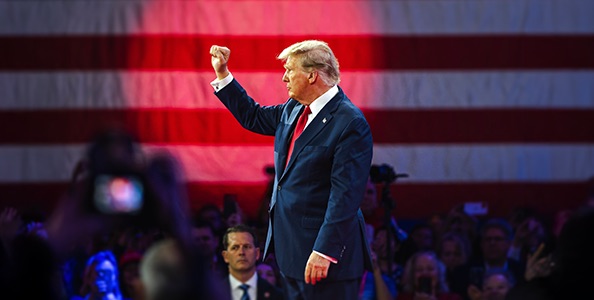Trump Wins the Presidency
Trump won! The President-elect is ready to take back America and fix it. Projected to win the presidency and gain Republican control over the House, Senate, and a Supreme Court in his favor, he is positioned to enact significant reforms. However, he is inheriting an economy wracked by four years of Bidenomics. And the changes needed to address economic instability won’t come easily. Trump is entering an economy teetering on the edge, and while his past policies brought gains, the underlying issues remain profound.
 1
1
President-elect Trump’s comprehensive vision for the country can have a profound impact on your financial future. The time to prepare for it is now.
Taxes
Trump’s agenda begins with an aggressive approach to tax reform. His administration plans to extend the 2017 Tax Cuts and Jobs Act. They are set to expire in 2025. He also wants to reduce the corporate tax rate further from 21% to 15%. While these measures are designed to boost short-term economic growth, critics caution that this could increase the national deficit significantly. Analysts project debt-to-GDP ratios to rise to 116% by 2028. Although Trump hopes these cuts will stimulate enough GDP growth to outpace the deficit. Yet the immediate gains may come at the cost of long-term fiscal stability.2
For now, the national debt continues to soar. It is growing at an unprecedented pace of $1 trillion every 100 days. The Bank of America has warned that unchecked debt could lead to a dollar crash. In such an environment, assets may not appreciate in real terms; rather, the dollar itself is depreciating. Which further supports the case for non-dollar assets as a hedge against the looming fiscal crisis.3
Tax cuts are likely to bring relief to average Americans. But the ensuing budget shortfalls could lead to painful trade-offs. Benefits and public services may be at risk if funds are cut to balance the deficit.
Elon Musk said the process to get the economy back on sound footing will cause “economic pain.” He agreed with a post that said, “Elon hacking away at the government, firing people and reducing the deficit – there will be an initial severe overreaction in the economy – this economy propped up with debt (generating asset bubbles) and artificially suppressed wages (as a result of illegal immigration). Markets will tumble.”4
Trade, Tariffs, and the Risk of Rising Inflation
One of Trump’s signature policies centers on tariffs. He plans to ramp them up to as high as 20% on all imports and up to 60% on goods from China. These measures aim to bring jobs back to the U.S. and strengthen domestic industries. However, they also risk inflating prices across a range of goods. Consumers will likely bear the brunt of this shift in the form of higher prices, which could reduce household spending and erode gains from tax cuts.5
For investors, Trump’s trade policies could introduce a layer of market volatility. While domestic industries might find an edge, the broader economic impact of a trade war remains unpredictable.
Impact on Retirement Funds
Under Trump’s previous administration, the stock market experienced significant gains. The Dow Jones Industrial Average rose by 57%. If his policies are implemented as planned, some sectors could see similar gains, potentially benefiting retirement funds like 401(k)s and IRAs. Yet, as history has shown, periods of rapid growth often come with increased market volatility, which can threaten retirement security.6
Geopolitical and Digital Risks Loom Large
The landscape President Trump faces also includes unprecedented geopolitical risks. Two major conflicts are heightening global instability that could rattle markets and further impact the economy. Additionally, the continuing push for a digital dollar introduces new uncertainties about privacy and government control. It is sparking concerns over the potential loss of individual financial freedoms.
Gold
The unpredictable economic landscape is making gold an attractive option. Particularly as central banks worldwide continue to stockpile the precious metal. Gold has already surged by 80% since 2020. Amid rising debt, fiscal uncertainty, and geopolitical tensions, many investors are shifting away from dollar-denominated assets in favor of tangible assets like gold and silver. The ongoing trend of de-dollarization by BRICS nations further threatens the dollar’s dominance while increasing gold demand. Gold is predicted to rise above $4,000 an ounce over the next few years. 7
Conclusion
Trump’s victory may signal a new direction, but the journey is fraught with economic and political challenges. His administration will have to navigate complex trade-offs, balancing tax cuts and deregulation with the risks of inflation, deficits, and geopolitical strife. The American people must prepare for an era of economic transition. Gains may come at a cost and adjustments may be necessary to ensure long-term financial stability. Tangible assets like physical gold held in a Gold IRA could be the best defense against the uncertain times ahead.






